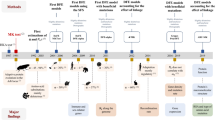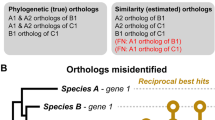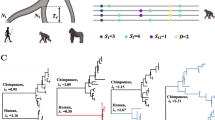Abstract
In 2005, Wyckoff and coworkers described a surprisingly strong correlation between Ka/Ks and Ks in several data sets using the LPB93 algorithm. This finding indicated the possibility of a paradigm shift in the way selection strength can be measured using the Ka/Ks ratio. We carried out a calculation of Ka and Ks using six different algorithms on three cross-species orthologous data sets and found a highly variable correlation among the algorithms and lineages. Algorithms based on the GY-HKY substitution model exhibit a weaker positive correlation or a stronger negative correlation than those based on the K2P and JC69 substitution model. Even if one algorithm shows a positive correlation between Ka/Ks and Ks in a warm-blooded lineage, it may show no correlation in a cold-blooded lineage. This algorithm-related and evolutionary lineage-related correlation indicates the need for great caution in drawing conclusions when using only one Ka and Ks algorithm in a genomewide analysis of selection strength. Our results indicated that currently used algorithms for Ka and Ks calculations are flawed and need improvements.



Similar content being viewed by others
References
Bernardi G (1993) The vertebrate genome: isochores and evolution. Mol Biol Evol 10:186–204
Bernstein SBR (1999) Elements of statistics II: inferential statistics. McGraw-Hill, New York
Chamary JV, Parmley JL, Hurst LD (2006) Hearing silence: non-neutral evolution at synonymous sites in mammals. Nat Rev Genet 7:98–108
Domazet-Loso T, Tautz D (2003) An evolutionary analysis of orphan genes in Drosophila. Genome Res 13:2213–2219
Fay JC, Wu CI (2001) The neutral theory in the genomic era. Curr Opin Genet Dev 11:642–646
Goldman N, Yang Z (1994) A codon-based model of nucleotide substitution for protein-coding DNA sequences. Mol Biol Evol 11:725–736
Hasegawa M, Kishino H, Yano T (1985) Dating of the human-ape splitting by a molecular clock of mitochondrial DNA. J Mol Evol 22:160–174
Ina Y (1995) New methods for estimating the numbers of synonymous and nonsynonymous substitutions. J Mol Evol 40:190–226
Jukes TH, Cantor CR (1969) Evolution of protein molecules. In: Munro HN (ed) Mammalian protein metabolism. Academic Press, New York, pp 21–123
Kimura M (1980) A simple method for estimating evolutionary rates of base substitutions through comparative studies of nucleotide sequences. J Mol Evol 16:111–120
Kimura M (1983) The neutral theory of molecular evolution. Cambridge University Press, Cambridge
Li WH (1993) Unbiased estimation of the rates of synonymous and nonsynonymous substitution. J Mol Evol 36:96–99
Li WH (1997) Molecular evolution. Sinauer Associates, Sunderland
Li WH, Wu CI, Luo CC (1985) A new method for estimating synonymous and nonsynonymous rates of nucleotide substitution considering the relative likelihood of nucleotide and codon changes. Mol Biol Evol 2:150–174
Liao B-Y, Zhang J (2006) Evolutionary conservation of expression profiles between human and mouse orthologous genes. Mol Biol Evol 23:530–540
Lynch M, Conery JS (2000) The evolutionary fate and consequences of duplicate genes. Science 290:1151–1155
Muse SV (1996) Estimating synonymous and nonsynonymous substitution rates. Mol Biol Evol 13:105–114
Nei M, Gojobori T (1986) Simple methods for estimating the numbers of synonymous and nonsynonymous nucleotide substitutions. Mol Biol Evol 3:418–426
Nei M, Kumar S (2000) Molecular evolution and phylogenetics. Oxford University Press, New York
Ohta T (1995) Synonymous and nonsynonymous substitutions in mammalian genes and the nearly neutral theory. J Mol Evol 40:56–63
Posada D, Crandall KA (2001) Selecting the best-fit model of nucleotide substitution. Syst Biol 50:580–601
Rice P, Longden I, Bleasby A (2000) EMBOSS: the European Molecular Biology Open Software Suite. Trends Genet 16:276–277
Tamura K, Nei M (1993) Estimation of the number of nucleotide substitutions in the control region of mitochondrial DNA in humans and chimpanzees. Mol Biol Evol 10:512–526
Tzeng YH, Pan R, Li WH (2004) Comparison of three methods for estimating rates of synonymous and nonsynonymous nucleotide substitutions. Mol Biol Evol 21:2290–2298
Vallender E, Lahn B (2007) Uncovering the mutation-fixation correlation in short lineages. BMC Evol Biol 7:168
Wyckoff GJ, Malcom CM, Vallender EJ, Lahn BT (2005) A highly unexpected strong correlation between fixation probability of nonsynonymous mutations and mutation rate. Trends Genet 21:381–385
Yang Z (2006) Computational molecular evolution. Oxford University Press, Oxford
Yang Z (2007) PAML 4: phylogenetic analysis by maximum likelihood. Mol Biol Evol 24:1586–1591
Yang Z, Bielawski JP (2000) Statistical methods for detecting molecular adaptation. Trends Ecol Evol 15:496–503
Yang Z, Nielsen R (2000) Estimating synonymous and nonsynonymous substitution rates under realistic evolutionary models. Mol Biol Evol 17:32–43
Zhang J, Rosenberg HF, Nei M (1998) Positive Darwinian selection after gene duplication in primate ribonuclease genes. Proc Natl Acad Sci USA 95:3708–3713
Zhang Z, Jun Y (2006) Evaluation of six methods for estimating synonymous and nonsynonymous substitution rates. Genom Proteom Bioinform 4:173–181
Zhang Z, Li J, Yu J (2006) Computing Ka and Ks with a consideration of unequal transitional substitutions. BMC Evol Biol 6:44
Zhang Z, Li J, Zhao X, Wang J, Wong GK, Yu J (2006) KaKs_Calculator: calculating Ka and Ks through model selection and model averaging. Genom Proteo Bioinform 4(4):259–263
Acknowledgments
We thank Laurie Goodman for her extensive editing of our manuscript. We thank Lin Fang, Jia Ye, and Hongkun Zheng for their constructive comments on this work. This project was supported by the Chinese Academy of Sciences (KSCX2-YW-N–023, GJHZ0701-6), the Ministry of Science and Technology under high-tech program 863 (2006AA02Z334, 2006AA10A121), the National Natural Science Foundation of China (90608010, 90403130, 30221004, 90612019, 30392130), and the Beijing Municipal Science and Technology Commission (D07030200740000). The project was also supported by Ole Rømer grants from the Danish Natural Science Research Council and the Danish Medical Research Council. J.L. collected the data and carried out all analyses. J.L., Z.Z., and S.V. wrote the manuscript. J.Y., G.K.W., and J.W. designed and coordinated the study. All authors read and approved the final manuscript.
Author information
Authors and Affiliations
Corresponding authors
Additional information
Jun Li, Zhang Zhang and Søren Vang contributed equally to this work.
Rights and permissions
About this article
Cite this article
Li, J., Zhang, Z., Vang, S. et al. Correlation Between Ka/Ks and Ks is Related to Substitution Model and Evolutionary Lineage. J Mol Evol 68, 414–423 (2009). https://doi.org/10.1007/s00239-009-9222-9
Received:
Revised:
Accepted:
Published:
Issue Date:
DOI: https://doi.org/10.1007/s00239-009-9222-9




